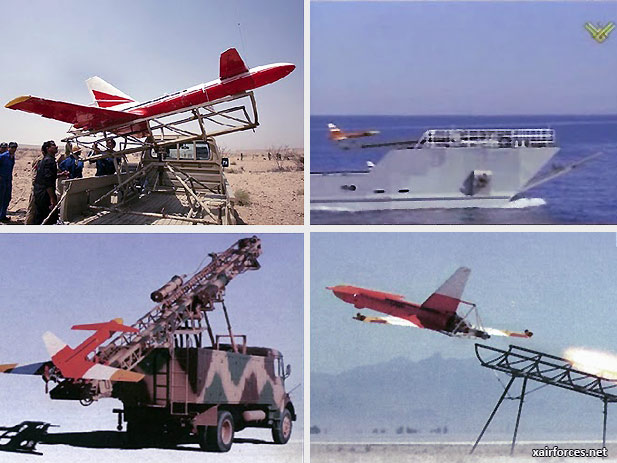
Israel Braces for Swarms of Iranian UAVs

Israel recently went public with their fears that the Lebanese based terrorist group Hezbollah was preparing to use UAVs obtained from Iran for attacks on Israel.
Actually this threat is already a decade old but Israel has usually been quiet about what they are doing about it. Israel has not released any details and simply stated that measures are being taken to deal with the threat.
As far back as 2009 the Israeli Air Force held training exercises where they used Chinese UAVs for target practice. An F-16 pilot went up, located the small UAV, and then shot it down with his 20mm cannon. Finding small UAVs is not easy, either with radar or the naked eye. Once you find them, shooting them down is comparatively easy. The Israelis are concerned about more UAVs coming from Lebanon, where Hezbollah has some. Thus the very realistic training.
The UAV threat is very real. Back in late 2004 Hezbollah sent a small UAV down Israel's Mediterranean coast, where it flew over an Israeli town for 15 minutes and then flew back into Lebanon. Hezbollah called their UAV "Mirsad 1", but it was actually an Iranian Ababil. The Iranians have been developing UAVs since the 1990s. Their Ababil is an 83 kg (183 pound) UAV with a three meter (ten foot) wing span, a payload of about 36 kg (80 pounds), a cruising speed of 290 kilometers an hour and an endurance of 90 minutes. The Ababil is known to operate as far as 120 kilometers from its ground controller. But it also has a guidance system that allows it to fly a pre-programmed route and then return to the control of its controllers for a landing (which is by parachute). The Ababil can carry a variety of day and night still and video cameras. There are many inexpensive and very capable cameras available on the open market, as is the equipment needed to transmit video and pictures back to the ground. In the last decade the Ababil has been improved and now has a range (from the operator) of 240 kilometers and is designed to carry a 45 kg (99 pound) warhead.
The Israeli air defense organization was embarrassed by the 2004 undetected UAV flight. But it wasn't the first time. In 1987, a Hizbollah commando flew undetected into northern Israel using an ultralight vehicle (somewhat larger than the Ababil), landed near a military camp, and killed six soldiers before he was killed. This led to the upgrading of the air defense system in northern Israel to prevent that sort of thing happening again. Since then, the Israelis have detected other ultralights and small aircraft trying to enter Israel, and stopped them. But during the 2004 incident the UAV moved at an altitude of under 100 meters (330 feet), and was the smallest aircraft the Israelis have had to deal with so far. Nevertheless, the Israeli air defenses were apparently supposed to be capable of spotting something like an Ababil UAV. Then in early 2005 another Ababil UAV flew about 30 kilometers into Israel, then turned around and reached Lebanese air space before Israeli fighters could catch up with it. There have been no more Hezbollah attempts to fly UAVs into Israel since. Detection systems have been improved in the last decade but there are still doubts.
What the Israelis fear most is low flying Ababils coming south carrying a load of nerve gas, or even just explosives. Using GPS guidance, such a UAV could hit targets very accurately. Moreover, there’s nothing exotic about UAV technology, at least for something like the Ababil. It was no surprise that Iran began using homemade UAVs in the late 1990s. After all, they had received some UAVs from the United States in the 1970s (Firebee target drones.) The Israelis immediately tagged Iran in 2004 as the supplier of the Hizbollah drone, because Iran has long supplied that terrorist organization with cash, weapons and equipment for decades.
Chinese UAVs are probably good for training Israeli pilots, as they are cheap, and similar to the Iranian Ababil. China is a decade or two behind the West in UAV design but have no problem exporting their UAV tech to Iran. Some Chinese UAVs may eventually show up using Israeli technology. In 2006 Israeli UAV manufacturer EMIT got busted after it was caught shipping UAV technology to China. EMIT was not a major player in the UAV industry, having only three models. The twenty year old firm has been scrambling to stay in business. The Chinese helped set up a phony cooperative deal in a Southeast Asian country, to provide cover for the transfer of EMIT UAV technology to China. Most of EMITs production is for export, but Israel has agreed to consult with the United States about transfers of technology to China. This is because Israel has been caught exporting military equipment, containing American technology, to China (in violation of agreements with the United States.)
Source: strategypage.com News - 1 April 2014
Photo: The Hezbollah Army Ababil UAV Launch Platforms (Photo by Fars News Agency)
(1.04.2014)
|